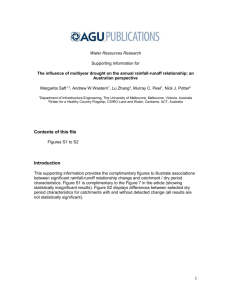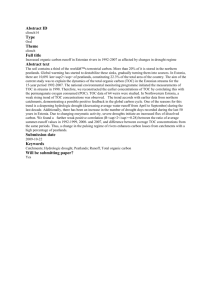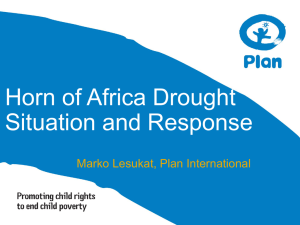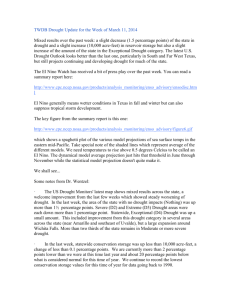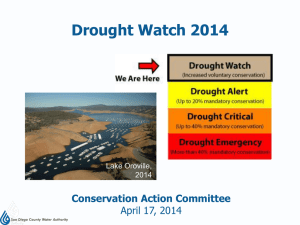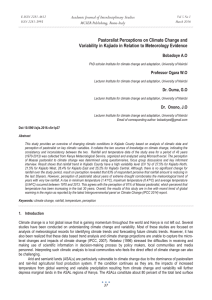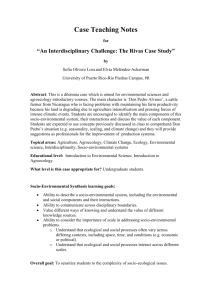Lesson learnt during implementation of Regional Drought Decision
advertisement
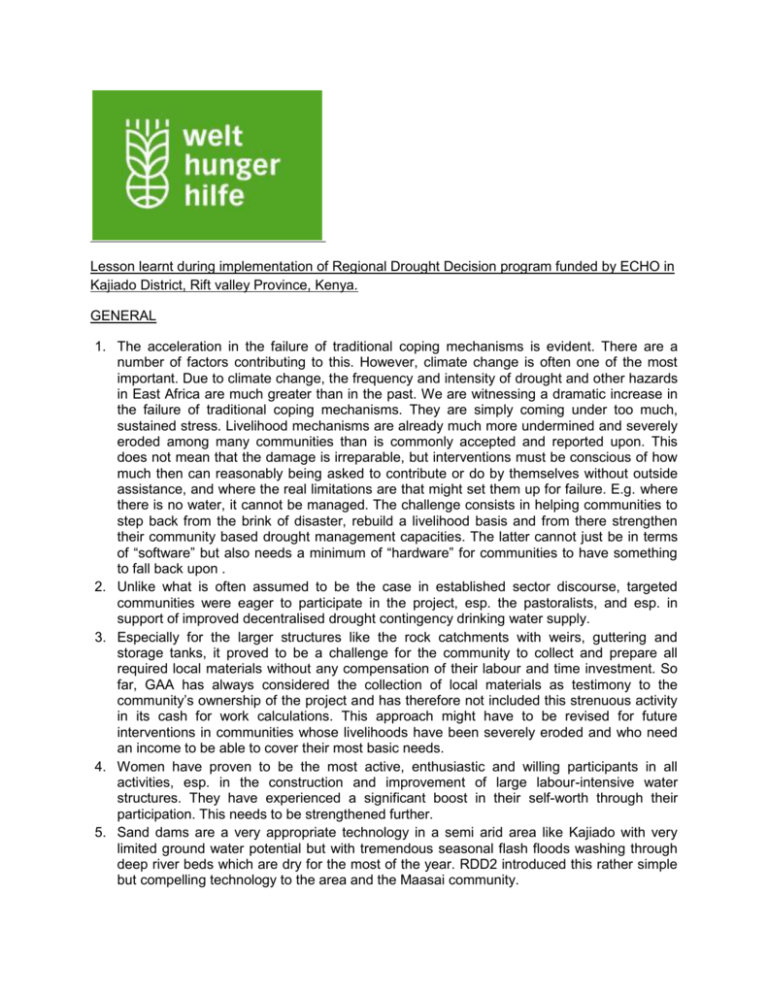
Lesson learnt during implementation of Regional Drought Decision program funded by ECHO in Kajiado District, Rift valley Province, Kenya. GENERAL 1. The acceleration in the failure of traditional coping mechanisms is evident. There are a number of factors contributing to this. However, climate change is often one of the most important. Due to climate change, the frequency and intensity of drought and other hazards in East Africa are much greater than in the past. We are witnessing a dramatic increase in the failure of traditional coping mechanisms. They are simply coming under too much, sustained stress. Livelihood mechanisms are already much more undermined and severely eroded among many communities than is commonly accepted and reported upon. This does not mean that the damage is irreparable, but interventions must be conscious of how much then can reasonably being asked to contribute or do by themselves without outside assistance, and where the real limitations are that might set them up for failure. E.g. where there is no water, it cannot be managed. The challenge consists in helping communities to step back from the brink of disaster, rebuild a livelihood basis and from there strengthen their community based drought management capacities. The latter cannot just be in terms of “software” but also needs a minimum of “hardware” for communities to have something to fall back upon . 2. Unlike what is often assumed to be the case in established sector discourse, targeted communities were eager to participate in the project, esp. the pastoralists, and esp. in support of improved decentralised drought contingency drinking water supply. 3. Especially for the larger structures like the rock catchments with weirs, guttering and storage tanks, it proved to be a challenge for the community to collect and prepare all required local materials without any compensation of their labour and time investment. So far, GAA has always considered the collection of local materials as testimony to the community’s ownership of the project and has therefore not included this strenuous activity in its cash for work calculations. This approach might have to be revised for future interventions in communities whose livelihoods have been severely eroded and who need an income to be able to cover their most basic needs. 4. Women have proven to be the most active, enthusiastic and willing participants in all activities, esp. in the construction and improvement of large labour-intensive water structures. They have experienced a significant boost in their self-worth through their participation. This needs to be strengthened further. 5. Sand dams are a very appropriate technology in a semi arid area like Kajiado with very limited ground water potential but with tremendous seasonal flash floods washing through deep river beds which are dry for the most of the year. RDD2 introduced this rather simple but compelling technology to the area and the Maasai community. 6. The use of cash for work to compensate the local unskilled labour contributing to improved WASH projects has proven to be very appropriate and is a highly appreciated tool among communities particularly at the peak of a drought. It should be continued on a declining basis also after the emergency situation, in order to help eroded livelihoods to recover. In the face of considerable losses of livestock and vastly increased food prices and other competing demands even long time after the drought, the sale (mostly bartering in areas away from main roads) of a small quantity of milk will not enable women and other vulnerable HH members to be better prepared for emergencies but will only help sheer survival. CFW which provides an excellent tool to help women retain / build a financial minimum during the project implementation period. Cash for work during the post drought period is especially used for exceptional major construction works; curing and other maintenance activities are considered as normal requirements for beneficiaries to sustain any structure being put in place. Moreover beneficiaries are trained on steps of activities including fundraising to be able to replicate any structure as long as needed which means that cash for work activities should not put the ability of communities’ replicability of small scale infrastructure into question. 7. The signing of a formal MoU between the project and a specific community stipulating mutual rights and obligations in the joint endeavour has proven to greatly enhance the sense of ownership among communities. Although it is a mere formal act, the use of this tool appears to make all the difference to boost community ownership. 8. While communities are eager to participate in the RDD type of project, their exposure and education level is generally still too low to go it alone. The project ensures community capacity building through trainings, the appointment of fully responsible local storekeepers to take care of materials delivered to the sites, the peer-selected nomination of community project attendants (CPAs) for monitoring activities, the further training of skilled local artisans and the continuous on-the-job training of community members in unskilled CFW labour. All these tools aim to enable communities to implement this type of project by themselves. However, while a good foundation has been laid under RDD2 and RDD3, most communities require much more support in terms of technical design and especially supervision to be able to handle this type of project by themselves. This is all the more true as building contractors usually only do as much as they are forced to do and often try to get away with cheap and shoddy workmanship. Their performance and quality output can only be assured through technically versed and close supervision which is a tremendous challenge for illiterate and generally poorly educated pastoral communities. 9. During trainings and also already during training needs assessments it was found that women are mostly illiterate and that they are also consistently much less educated than men. However, esp. for topics pertaining to public health it is of utmost importance to ensure that the women participating in trainings grasp the essentials of the subject content. Achieving this is life-saving when it comes to hygiene and nutritional basics for female caregivers. RDD3 will devote much more time to building the capacity of women through a variety of IEC tools. 10. While selected GOK staff display admirable commitment in supporting the project and the communities whom it works with, this can by no means be generalised. RDD3 will therefore continue to design activities in such a way that they ideally involve officers from relevant line ministries directly and that the transfer of ownership and support to communities is also the objective towards sustainability. The introduction of peer-selected community project attendants (CPAs) as major on-the-ground links between their specific communities and the project has proven to be immensely valuable and will be continued, ideally also mainstreamed into all other GAA WASH projects. 11. There appears to be a misconception among many policy makers and other stakeholders as a result of which existing community capacities to read early warning signs, interpret them and take early action are under-estimated. The Maasai in Kajiado, for example, are quite capable of doing this. The problem rather lies in their rapidly reducing scope of action. For example, most households moved their cattle out of the area again before the end of 2008 after just having returned. So they migrated to dry season pastures months earlier than in normal years. There they met large numbers of other herders with their cattle. In the face of reducing land to migrate to (sale, grabbing, urban sprawl, increased acreage under irrigation farming e.g. in Loitoktok, etc.), these dry season pastures deplete faster and are therefore unsustainable. Once this has happened, many herders run out of options. If they sell their cattle at this stage, terms of trade will be so unfavourable that the action will impoverish them further. They also do not really have the option of selling their animals much earlier, because with one drought following on the heels of another one, they would then never really own cattle any more at any point. In summary, the problem is not early warning or related to early action but the erosion of non-destructive coping mechanisms in the absence of more medium to long term social protection programmes, helping bridge the gap and without new options emerging fast enough to help provide solutions. Specific to types of water structures constructed 1. Rock catchments require huge investment and takes time to establish. Though once established, they are more easily operated and maintained by the communities .The technology has proven to be a suitable appropriate technology for drinking water to humans in dry lands. It emerged that communities adopt and own the idea and approach immediately. 2. Sand dams lined with protected shallows wells along seasonal river beds is a potential technology though underutilized in Kajiado District that can easily be adapted and replicated by communities. However the success of the sand dams depends on hydrological features of the selected locations .The key lesson learnt is that for sand dams to be successful, proper locations and design needs to be identified and developed. 3. Management of water structures by communities is directly linked to clarity of who owns the structure .Most well maintained structures are either privately owned or have a defined ownership group. The lesson learnt is that operation and maintenance of the water structures clearly depends on clarity of who owns the structure. 4. Sustainability of water structures is mostly attributed to poor management by communities .GAA experience during the implementation of RDD indicates that the quality of construction also attributes to the level of sustainability of the water structures. The key lesson learnt is that structures need to be well designed and high quality of masonry work ensured for structures to be maintained by the communities. 5. Although contribution of local materials by the communities ensures community participation; it undermines the quality of constructions. This is as a result of poor quality of materials contributed by communities . 6. Roof catchments both in schools and health centres are appropriate rain harvesting technologies suitable to institutions located in dry lands. All roof catchments constructed provided water to school children and teachers throughout the dry spells. The lesson learnt is that with a precipitate rate of 200mm- 300mm a year, roof catchments installed with 50m3 storage capacities can bridge between the dry and rainy spells.
